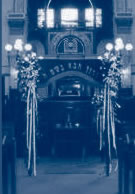|
SEDRA: Metzora- Hertz Chumash p. 470 Leviticus
Chaps. 14-15
This week's Sedra is generously sponsored by David Castelan.
SYNOPSIS:
T azria described the onset and diagnosis of the Tzara'at
condition - loosely translated : leprosy.
When the disease healed, the Kohen again examined the person
and if the recovery was complete he would undertake a ritual
of purification. This elaborate process took place over an
eight day period with special rites being observed on the
first and last days. These included washing, bathing and laundering
his clothes. On the eighth day he brought three sacrifices
: a guilt offering, a sin offering and a meal offering. A
poor man could bring smaller sacrifices. The person was then
pronounced Tahor (pure) and could resume living as part of
the community - society again. The laws of Tzara'at also applied
to garments and buildings. Here too, the investigations as
to the ritual fitness of the article or building would be
conducted by the Kohen. Garments with tzara'at were burnt.
Houses with signs of tzara'at were evacuated and boarded up
for seven days. If the contamination spread the affected parts
were removed and replaced. If the tazra'at still persisted
the building was demolished. All the materials were removed
from the site to a specially designated dump outside the camp.
The Sedra continues to discuss physical secretions which render
a person ritually unfit, especially for entry into the Sanctuary.
The nature of the issue or secretion and the restrictions
it imposes are set out as well as the mode of purification
including the sacrifices to be brought. While many of these
laws hardly apply today as we have no Temple service, the
laws of Niddah (a form of ritual impurity), family purity,
sexual intimacy and use of the Mikveh continue to form the
basis of the Jewish approach to family life and the sexual
relationship.
HAPHTORAH - in most Leap Years this Sedra concides with Shabbat
Hagadol. "The great Shabbat" HERTZ CHUMASH P. 1005
Malachi Chap. 3, verse 4
The Shabbat before Pesach is called Shabbat Hagadol. Reasons
for this name vary. One explanation refers to the final words
of the Haphtorah : "before the coming of the Great and
awesome day of the Lord". Malachi was the last of the
prophets, and this chapter ends his prophecy and indeed the
age of prophecy. It speaks of a future redemption to be heralded
by the return of Elijah, most zealous of the prophets. The
theme of the Haphtorah is one of repentance and rededication
to G-d, the Torah and a commitment to all the Mitzvot. "And
test me now in this says the Lord of Hosts, if I will not
open for you the windows of heaven and pour you out a blessing
with no lack of sufficiency". i.e. if we seriously commit
ourselves to G-d's way, we are assured of a blessed response.
Try it !
TELL ME RABBI ..... SEDER GUIDE
The first two nights of Pesach, we conduct a Seder - a festive
yet solemn event. At a table royally set we re-enact the exodus
from Egypt in ancient times. We also pray for the forthcoming
redemption speedily in our days. Each per son is to consider
himself as if he were going out of Egypt. We begin with our
ancestors, Abraham, Isaac and Jacob; we are with our people
as they descend into exile, and suffer cruel oppression and
persecution. We are with them when G-d sends the ten plagues
to punish Pharaoh and his nation, with them as they leave
Egypt, and with them at the crossing of the Sea of Reeds.
And we witness the miraculous hand of G-d as the waters part,
allowing the Israelites to pass, and then return, thundering
over the Egyptian legions.
THE SEDER PLATE
Three matzot are placed on the table, one on top of the other
symbolic of the three tribes of Jews: Kohen, Levi and Yisroel.
They also commemorate the three measures of fine flour which
Abraham told Sarah to bake into matzot when the three angels
visited them. When we break the middle matzah, we are still
left with two whole loaves for `lechem mishne', as on all
Sabbaths and Festivals. The following items are placed on
the plate :
1. Z'roah - shank bone or roasted chicken neck, symbolic of
the pascal sacrifice.
2. Botzah - the hard boiled egg, symbolic of the festival
sacrifice.
3. Maror - bitter herbs, raw horseradish, and/or leaves of
bitter continental lettuce or endive, symbolic of bitter suffering.
4. Charoset - the mixture of chopped apples, nuts and wine
resembles mortar.
5. Karpas - Parsley.
6. Chazeret - more bitter herbs. Used as maror in the `sandwich'
later in the Seder.
ORDER OF THE SEDER SERVICE
Kadesh - The recitation of Kiddush, proclaiming the holiness
of the holiday over a cup of wine, the first of four cups
we all drink, reclining, at the Seder. Why we Recline - We
lean on our left side to accentuate the fact that we are free
people. In ancient times only free people we allowed to reline
while eating.
Ur'chatz - Purification - We wash our hands in the prescribed
manner without the blessing.
Karpas - the `Appetiser' - A piece of parsley is dipped into
salt water the blessing over vegetables is recited and it
is eaten. The salt water represents the tears of our ancestors
in Egypt.
Yachatz - Breaking the Matzah - The middle matzah on the Seder
plate is broken in two. The larger part is the Afikoman. This
unusual action attracts the child's special attention and
recalls G-d's splitting the Sea of Reeds to make a path for
the Israelites to cross on dry land. The smaller part of matzah
is returned to the Seder plate. This broken matzah symbolises
humility and the `bread of poverty'.
Maggid - the Haggadah . At this point the poor are invited
to join the Seder; the Seder tray is moved aside; a second
cup of wine is poured; and the child, by now bursting with
curiosity, asks the time-honoured questions - Why is this
night different from all other nights? Why only matzah? Why
the dipping? Why the bitter herbs? Why are we relaxing, leaning
on cushions, as if we were kings? The questioning triggers
one of the most significant mitzvot of Pesach, and the highlight
of the Seder ceremony: the Haggadah, narration of the exodus
from Egypt. The answer includes a brief review of history,
the suffering imposed upon the Israelites; the plagues visited
upon the Egyptians, and an enumeration of the miracles performed
by the Al-mighty for the redemption of His people.
Rachtzah - Washing before the Meal
Motzie Matzah - Eating Matzah - Taking hold of the three matzot,
recite the customary blessing before bread. Holding the top
whole matzah with the broken middle one recite the blessing
`Al Achlat Matzah'. Break from each matzah and eat the two
pieces together reclining.
Maror - the Bitter Herbs- Take of the bitter herbs, dip it
in the charoset, shake the latter off and make the blessing
`Al AChlat Maror'. Eat without reclining.
Korech - the ` Sandwich' - Break off two pieces of the bottom
matzah. Take bitter herbs and dip them in charoset. Place
them between the pieces of matzah and say "Kein assa
Hillel..." Eat the `sandwich' reclining.
Shulchan Oreich - the Feast - Some begin the meal with a hard
boiled egg dipped into salt water. Why? It symbolise the Jew,
the more the egg is burned and boiled, the harder it gets.
Tzafun - Hidden - After the meal, the hidden half matzah -
set aside for the Afikoman `dessert' is eaten. It symbolises
the pascal lamb which was eaten at the end of the meal. After
the Afikoman, we do not eat or drink anything except for the
two remaining cups of wine.
Barech - Blessings after the Meal - A third cup of wine is
filled and grace is recited. After grace we recite the blessing
on wine and drink the third cup while reclining. Now we fill
the cup of Elijah and our own cups with wine. We open the
door and recite the passage which symbolises an invitation
to the Prophet Elijah.
Hallel - Songs of Praise - At this point, having recognised
the Al-mighty, and His unique guidance of His people Israel,
we go still further and turn to sing His praises as L-rd of
the entire Universe. After reciting the Hallel, we again recite
the blessing for wine and drink the fourth cup, reclining.
Nirtzah - Acceptance - Having carried out Seder service properly,
we are sure that it has been well received by the Al-mighty.
Next year in Jerusalem!
BACK TO SHABBAT SHALOM
TABLE
|








